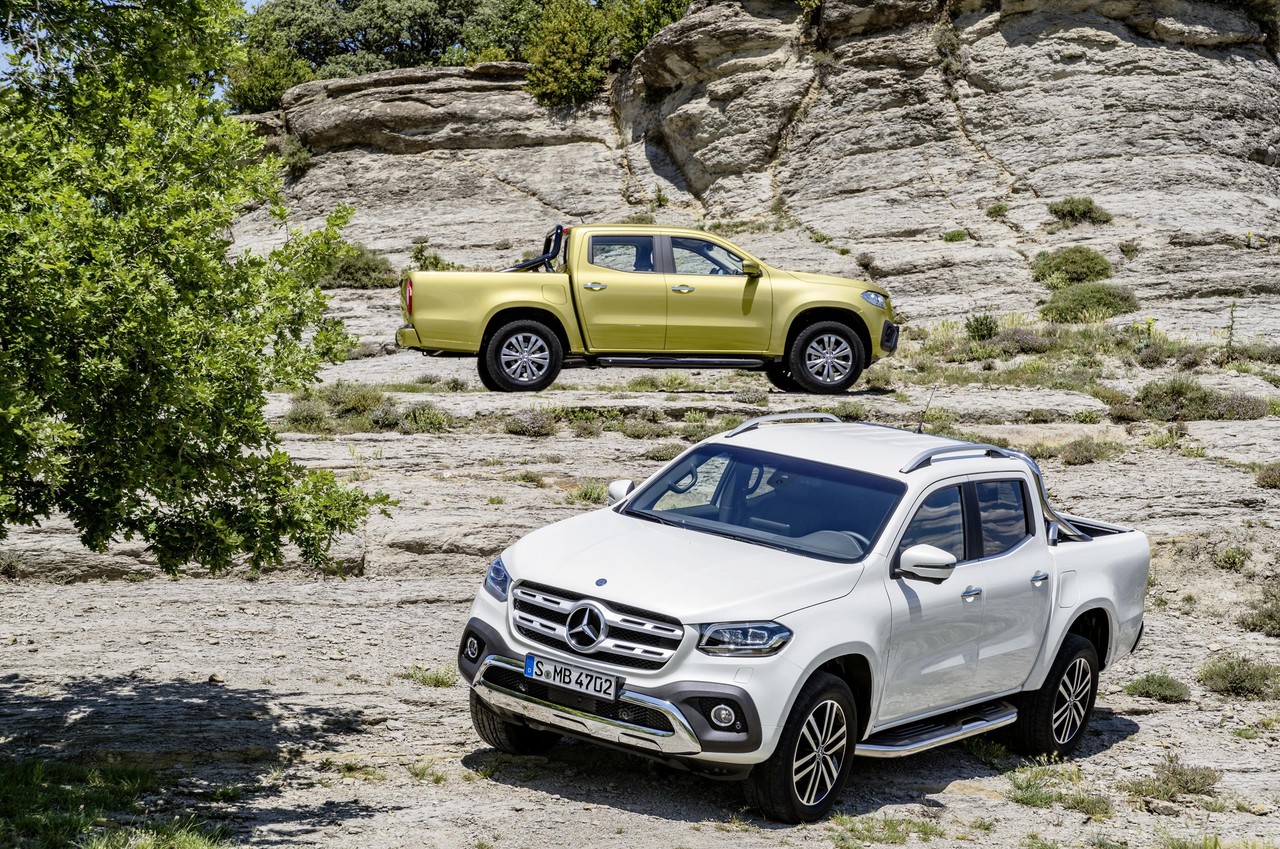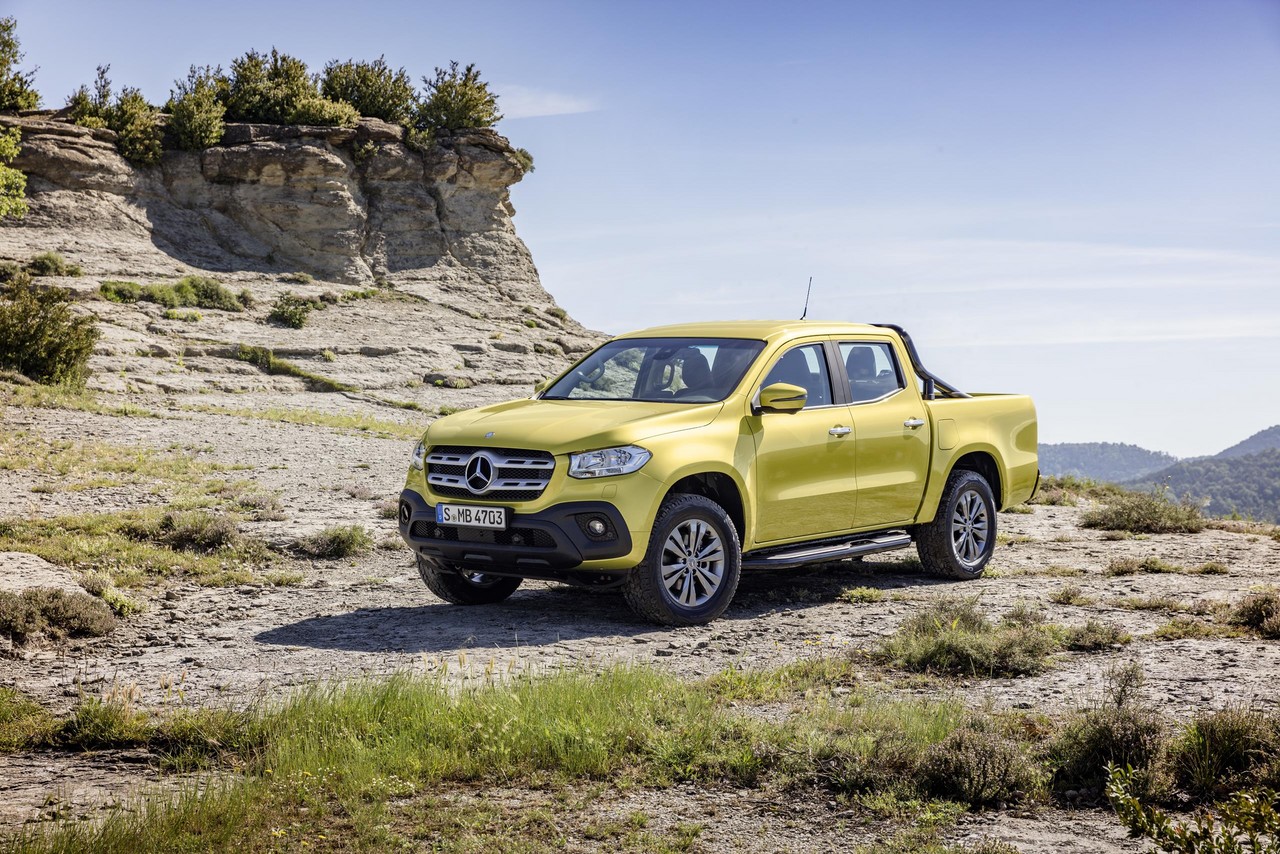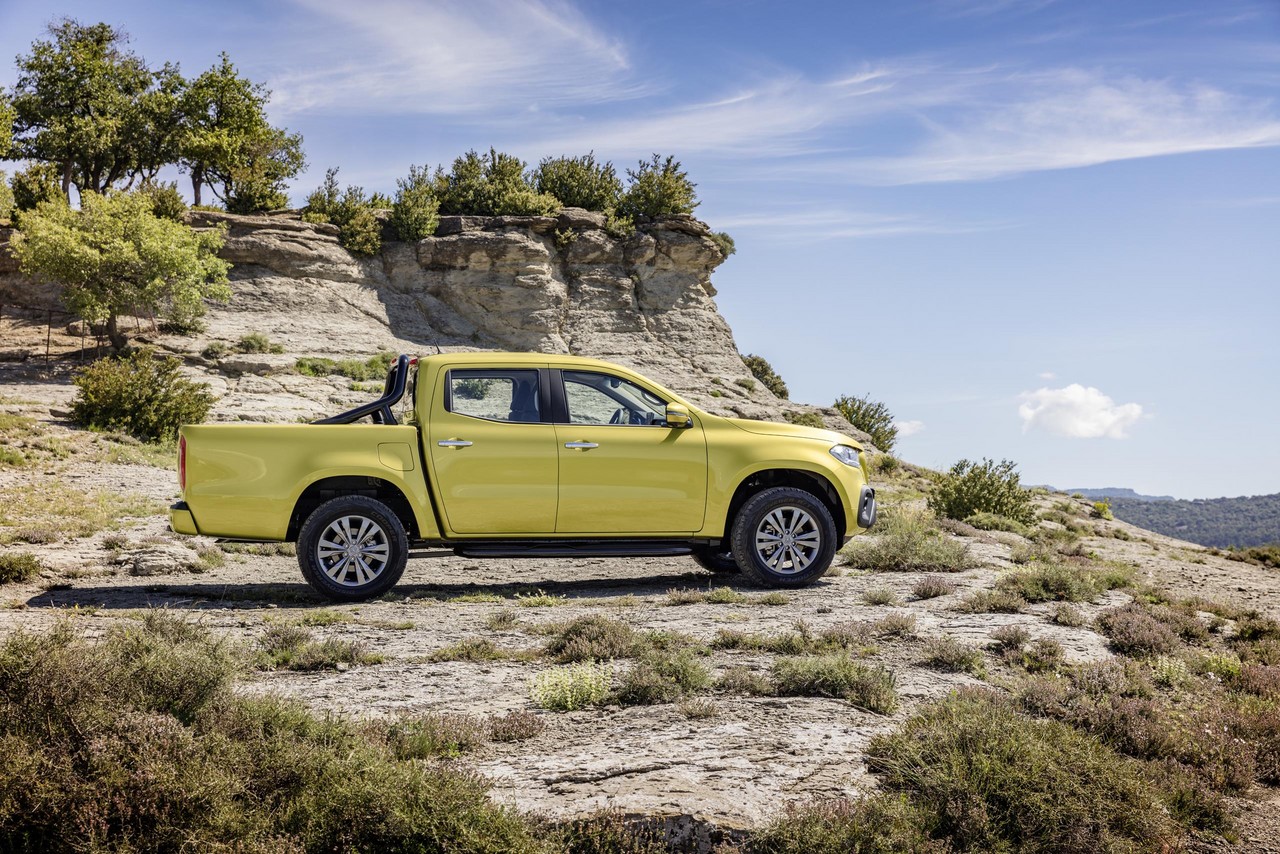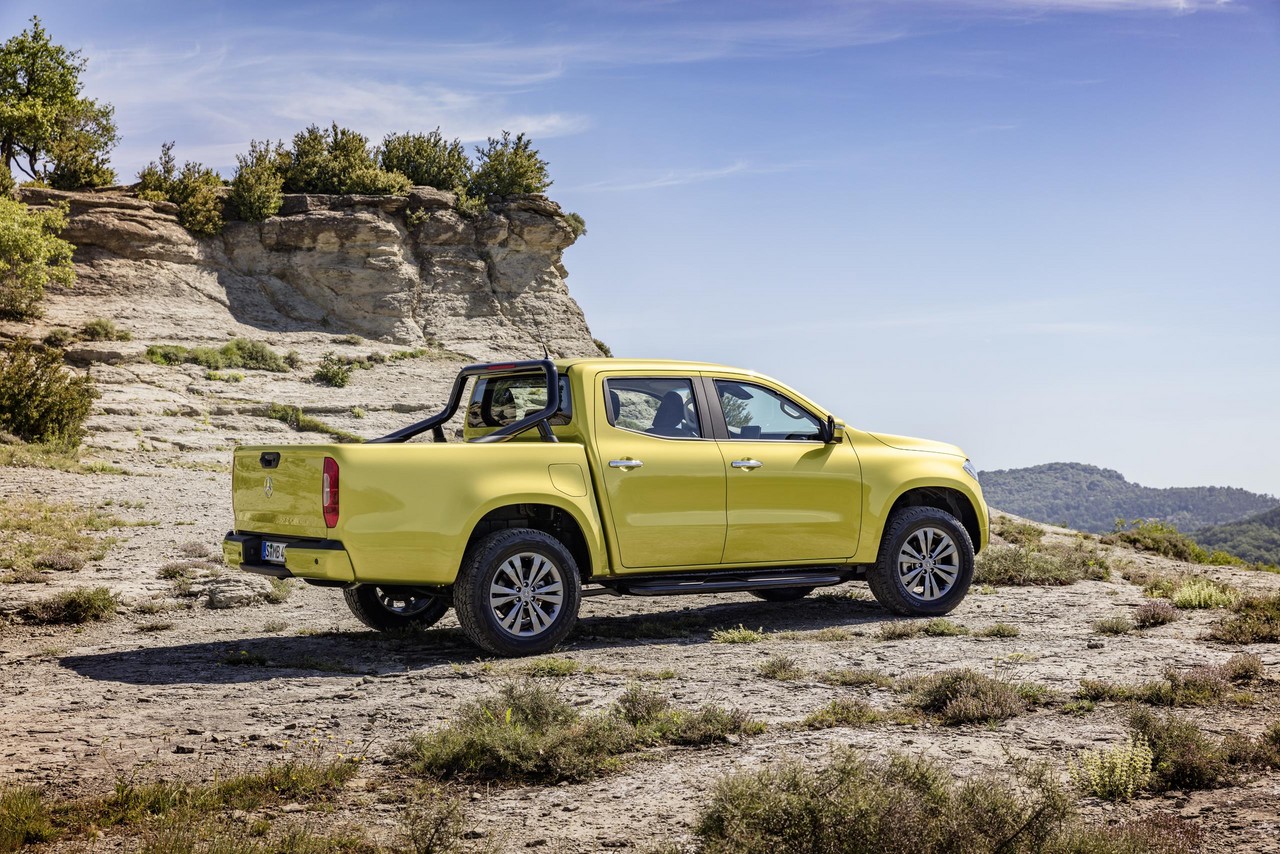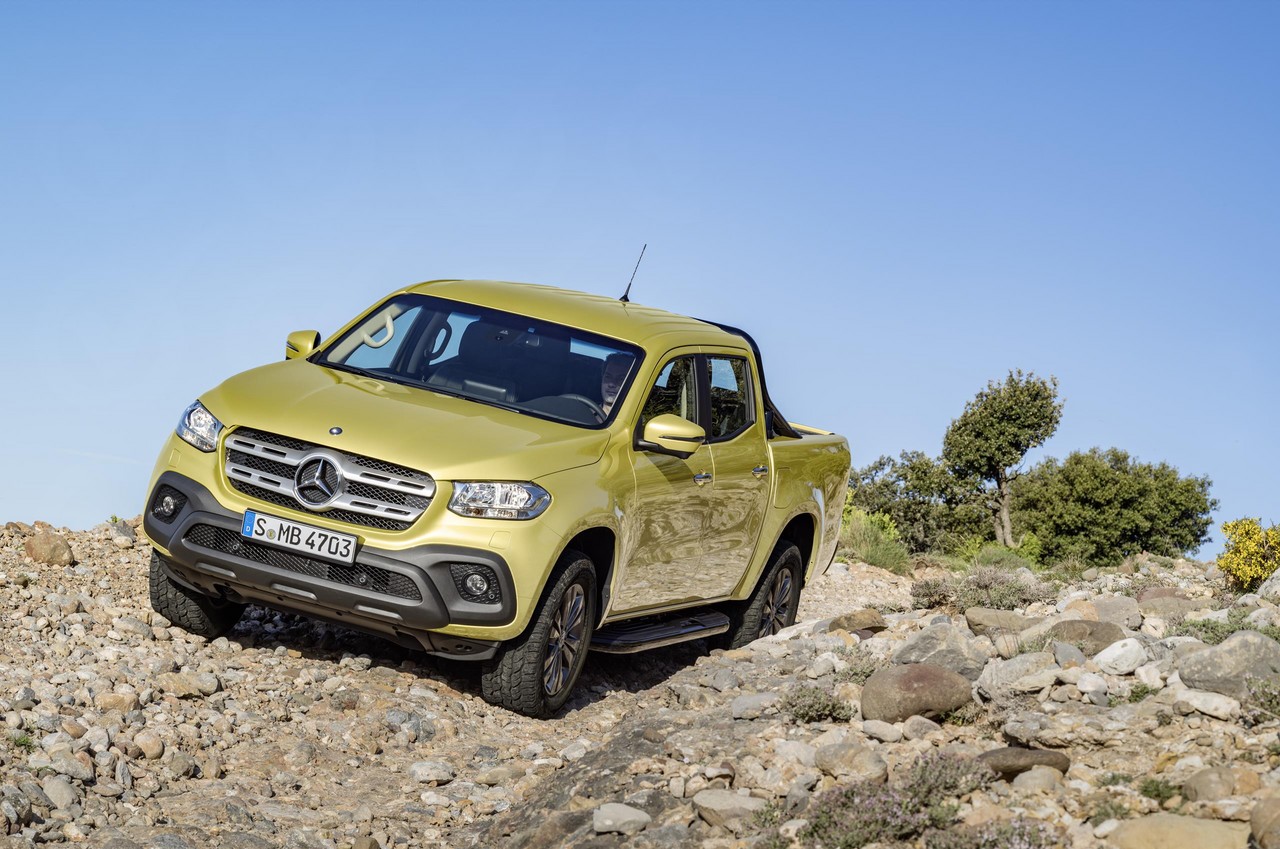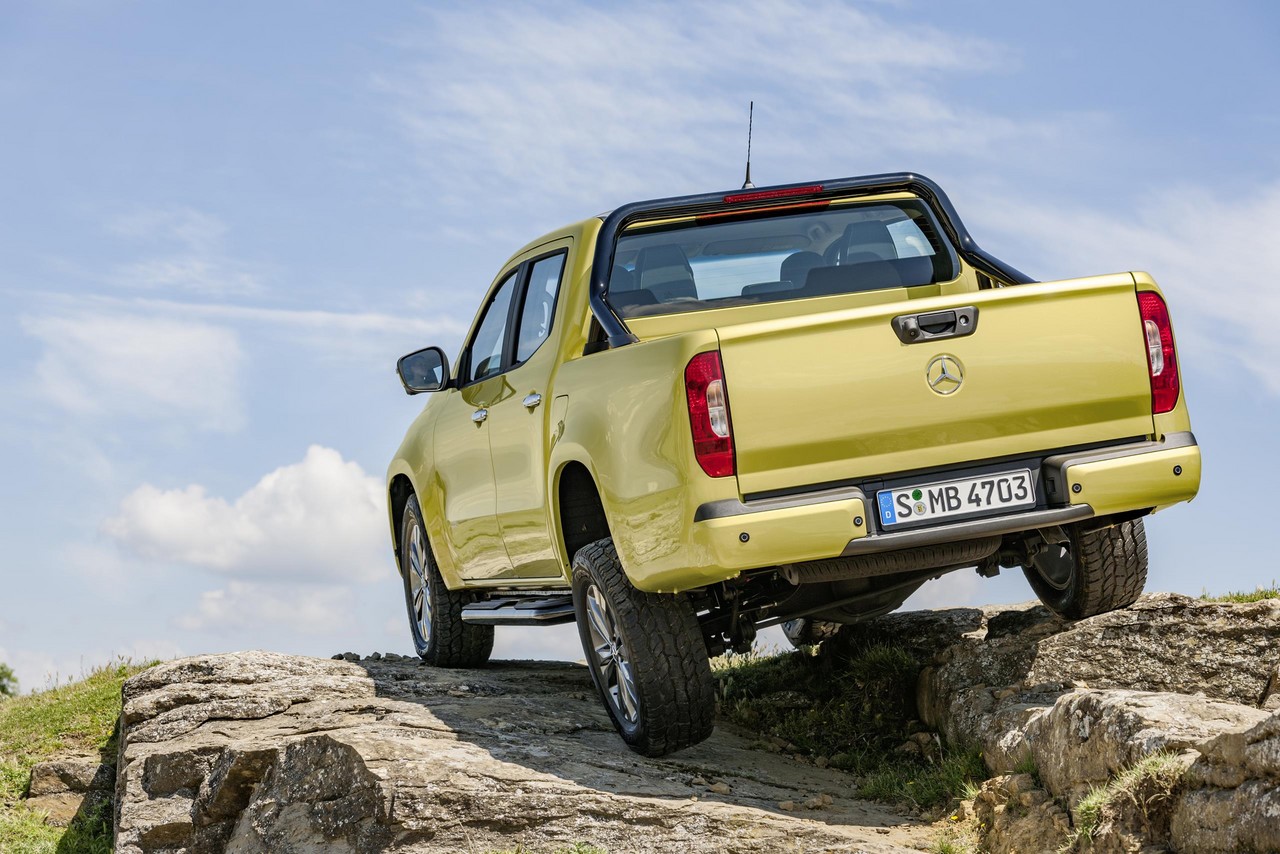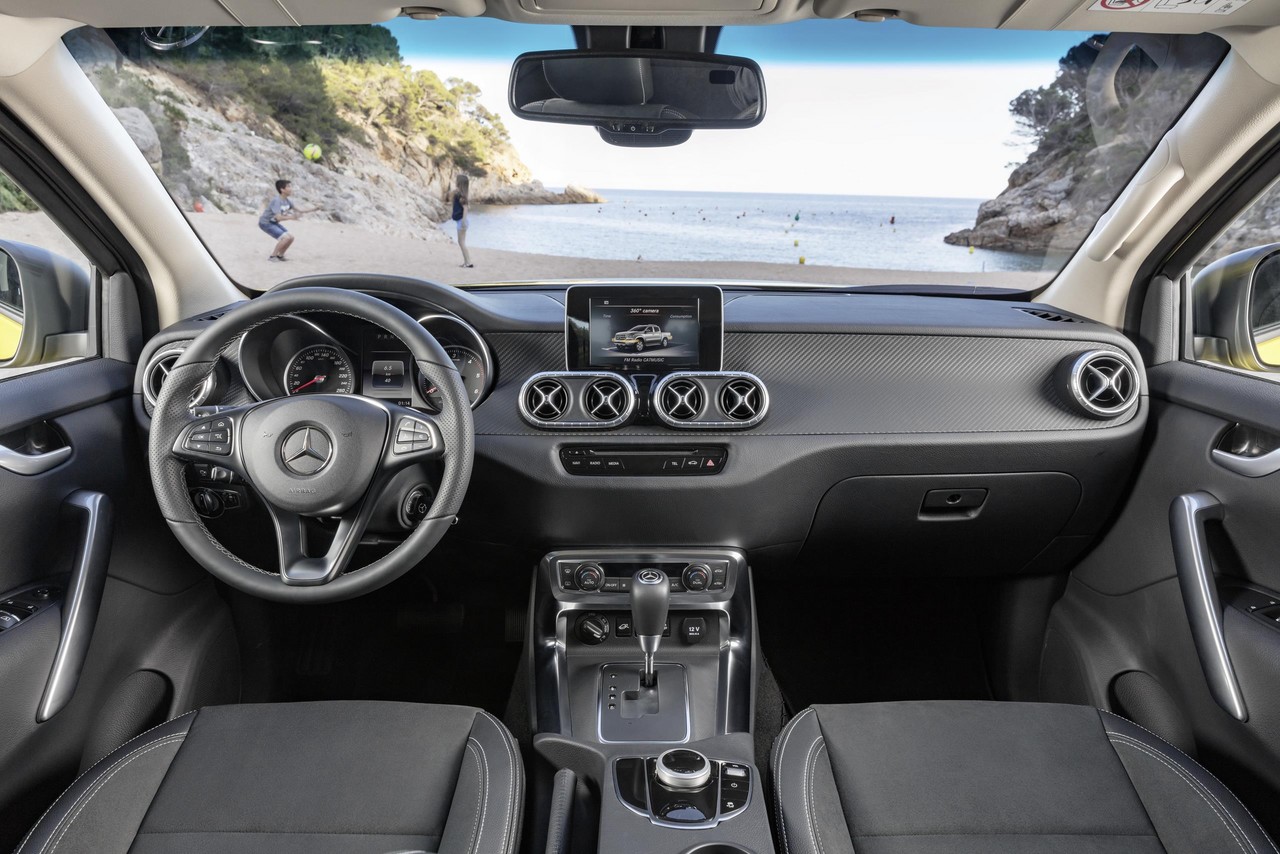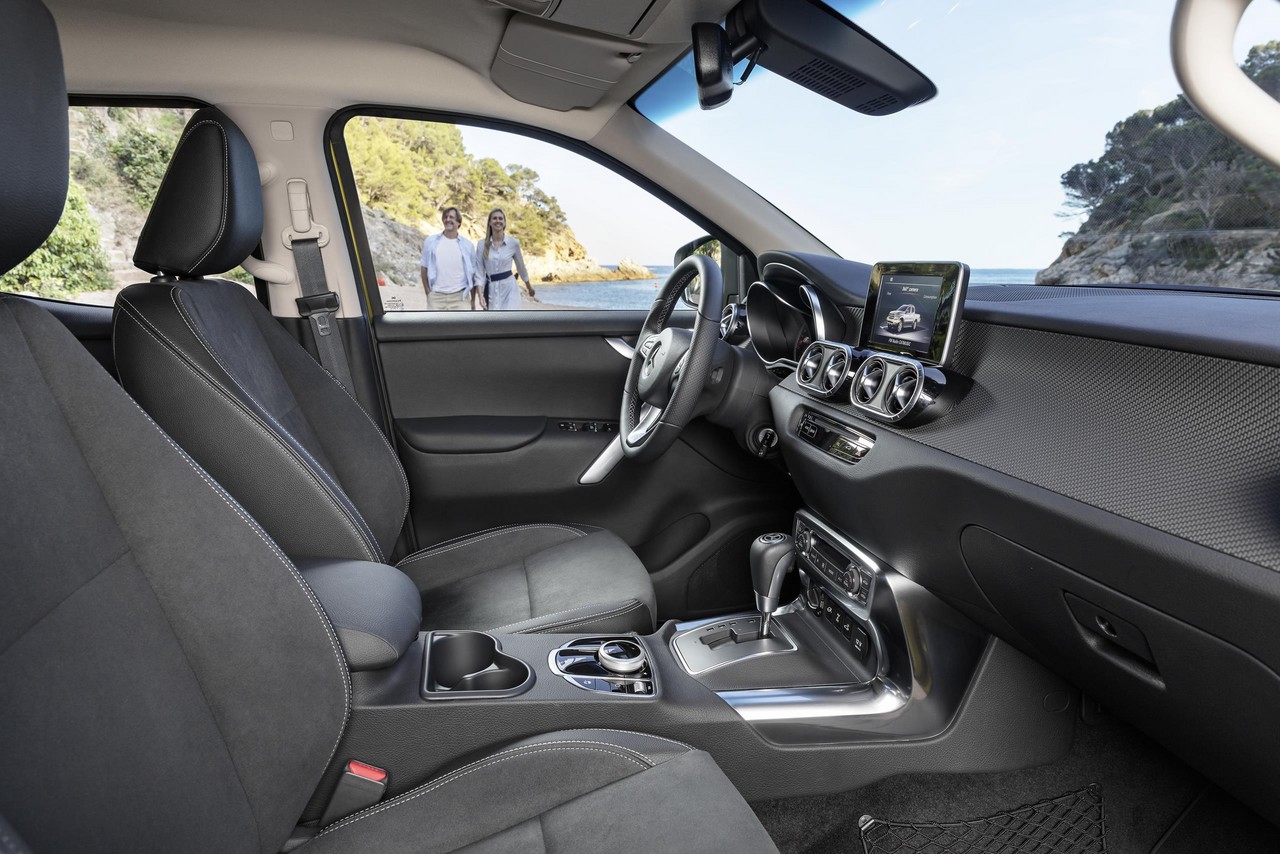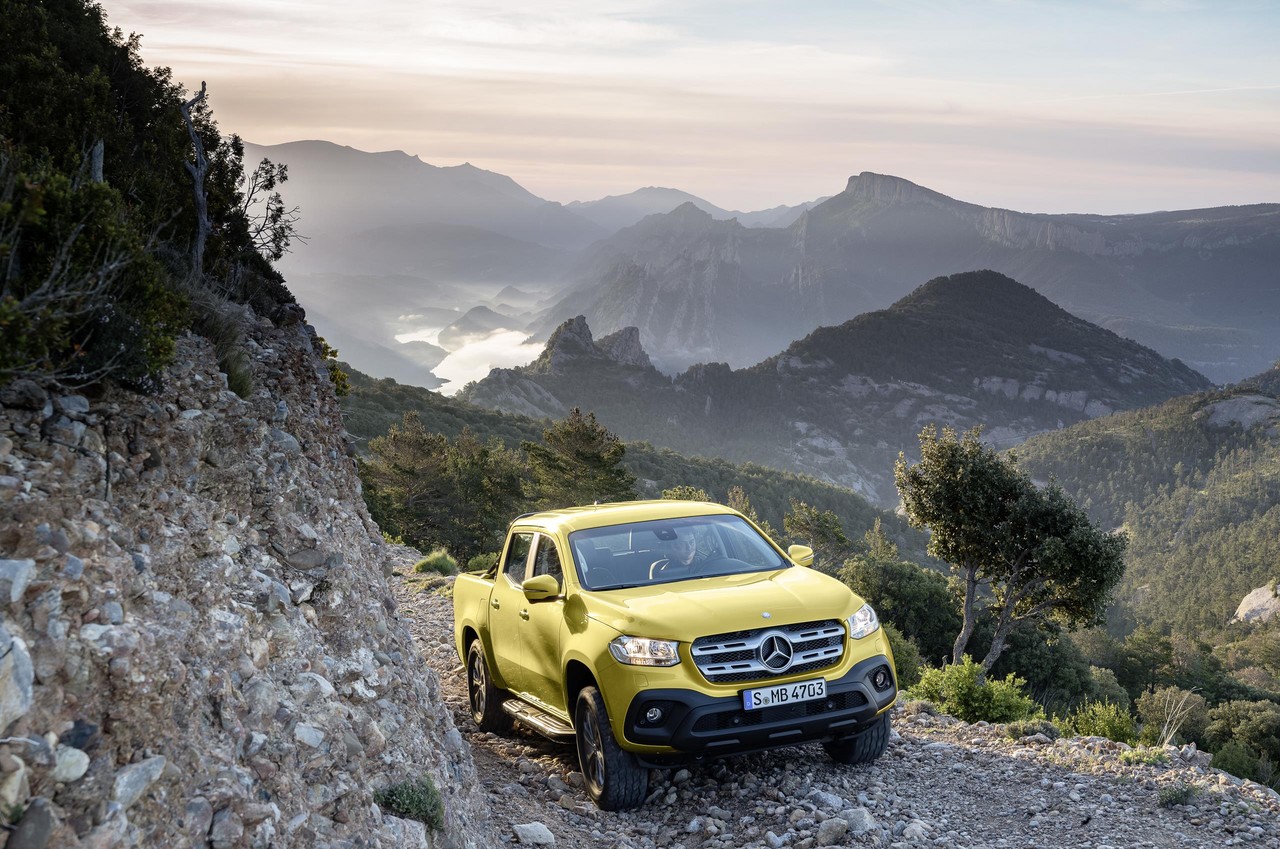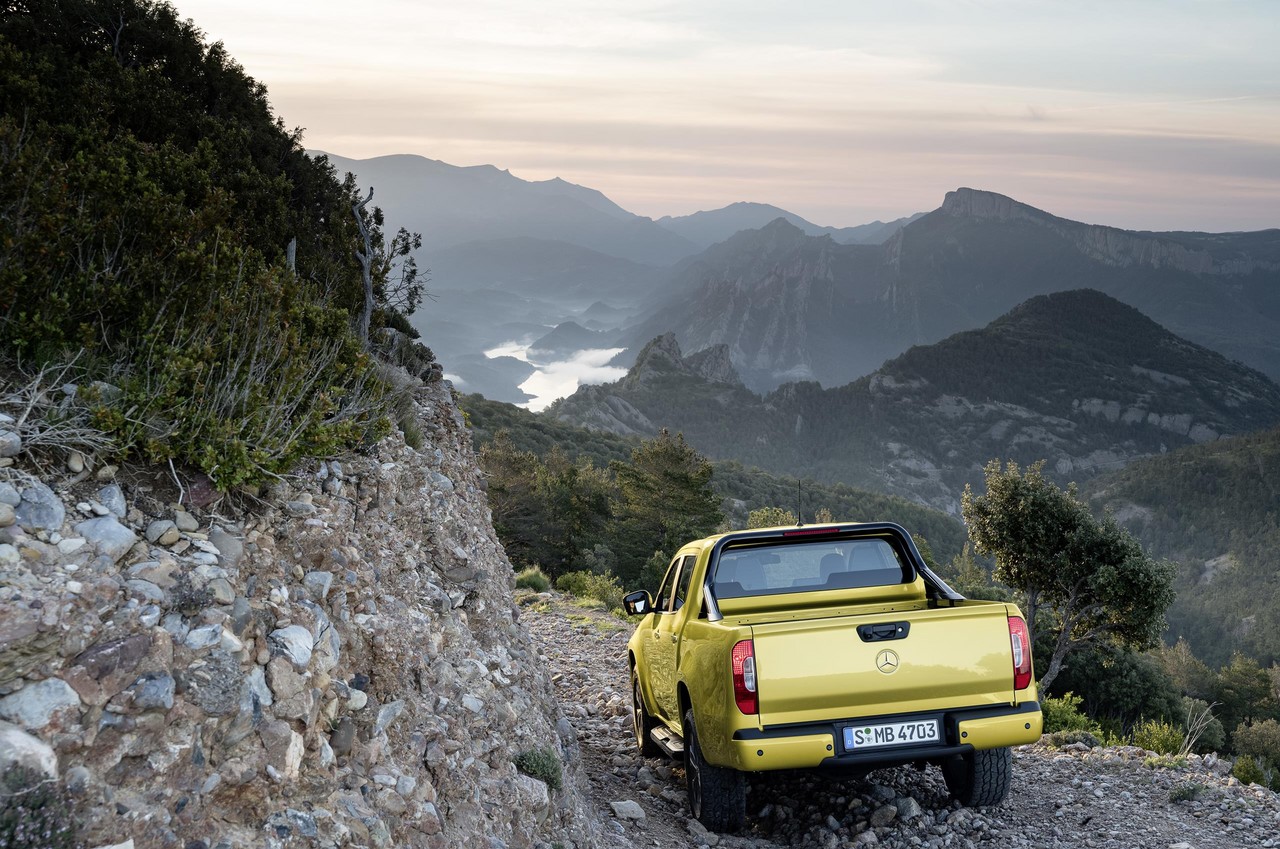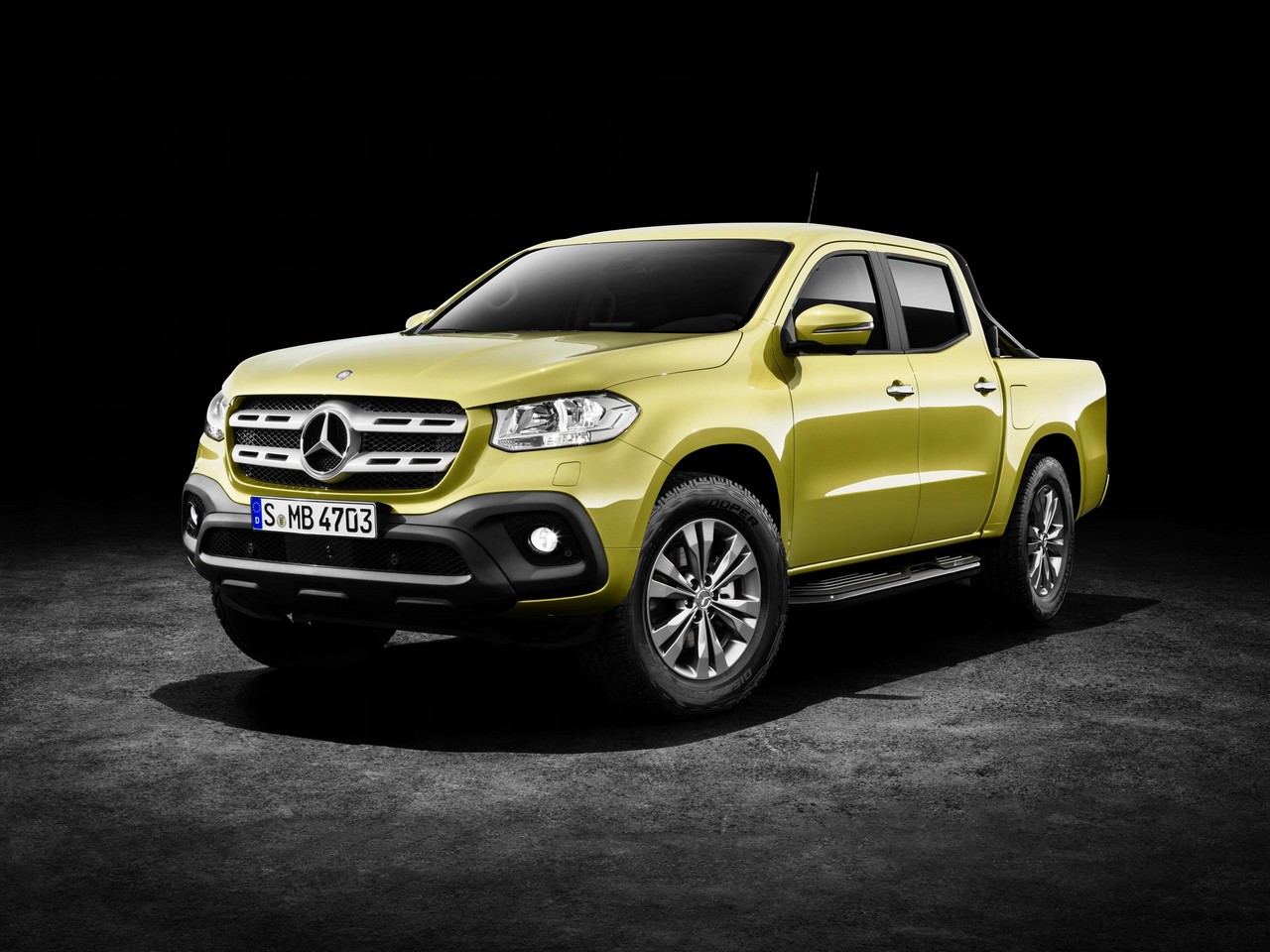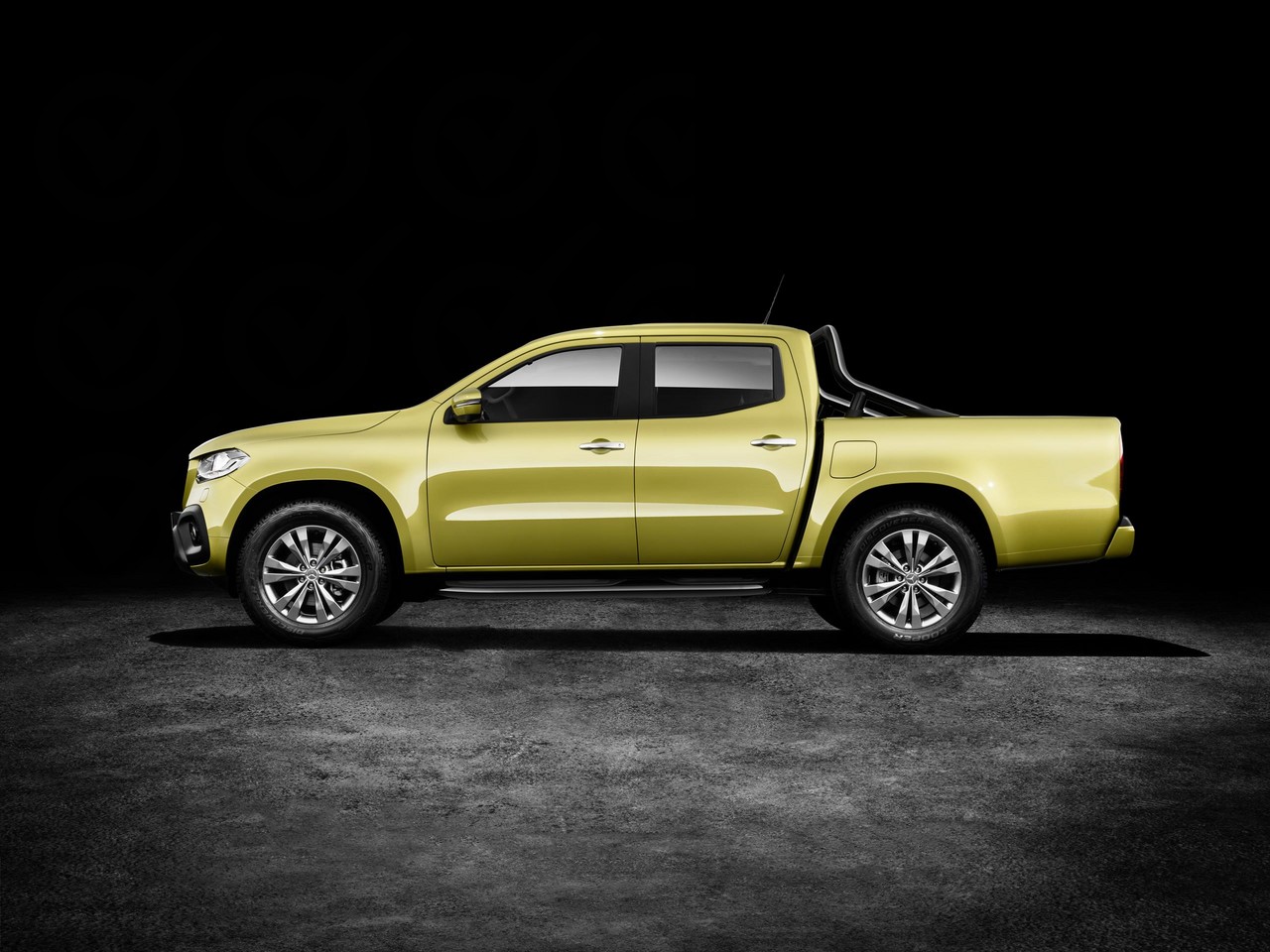
- Responsive and efficient turbo diesel engines
- Comfortable ride
- Quiet, well-insulated cabin
- Off-road capability
- Made by Nissan and powered by Nissan four-cylinder engines, but priced as Mercedes product
- Steering wheel lacks reach adjustment
- Steering weight?
Overview
Released in Australia in April 2018, the Mercedes-Benz X470 X-Class was available as a dual cab utility and cab chassis. Sharing the Nissan Navara’s NP300 platform and four-cylinder diesel engines, the Mercedes-Benz X-Class was initially available in X 220 d and X 250 d models, with the X 350 d following in mid-2018 (see table below). Furthermore, the X-Class range consisted of Pure, Progressive and Power variants. Australian-delivered X-Class vehicles were manufactured at Nissan’s Barcelona plant in Spain.
Engines: YS23DDT, YS23DDTT and OM642
Shared with the Nissan NP300 Navara , the YS23DDT and YS23DDTT engines had cast iron blocks, aluminium alloy cylinder heads, double overhead camshafts (chain-driven), common-rail injection, an intercooler, four valves per cylinder and a compression ratio of 15.4:1. Whereas the YS23DDT engine had a single turbocharger, the YS23DDTT engine for the X 250 d had a small turbocharger for low-rev operations and a larger turbocharger which also engaged at higher engine speeds.
The Mercedes-Benz X 350 d is powered by Mercedes-Benz’s OM642 diesel engine which had an aluminium alloy block and cylinder head, double overhead camshafts (duplex chain driven), a variable geometry turbocharger, common-rail direct injection via piezo injectors, a compression ratio of 18.0:1, a diesel particulate filter and selective catalytic reduction (SCR) which injected AdBlue solution into the exhaust gases. To reduce fuel consumption, the X 350 d engine had an ECO start/stop function which could shut down the engine when the vehicle was stationary in traffic to reduce fuel consumption.
| Engine | Drive | Trans. | Peak power | Peak torque | |
|---|---|---|---|---|---|
| X 220 d | 2298 cc YS23DDT turbo diesel I4 | RWD, 4MATIC |
6sp man., 7sp auto |
120 kW at 3750 rpm | 403 Nm at 1500-2500 rpm |
| X 250 d | 2298 cc YS23DDTT biturbo diesel I4 | 4MATIC | 6sp man., 7sp auto |
140 kW at 3750 rpm | 450 Nm at 1500-2500 rpm |
| X 350 d | 2987 cc OM642 turbo diesel V6 | 4MATIC | 7sp auto | 190 kW at 3600 rpm | 550 Nm at 1600 rpm |
4MATIC all-wheel drive: engageable and permanent systems
The ‘engageable’ four-wheel drive system (‘4MATIC’) for the Mercedes-Benz X-Class had dual range gearing and the front wheels could be engaged via a rotary switch while the vehicle was being driven at speeds up to 100 km/h. To engage the front wheels, a dog clutch would close such that torque would be distributed between the front and rear axles in a 50:50 split. Furthermore, the dual range gearing enabled the driver to select from 4H and 4L (low-range) drive modes, the latter using a 1:2.7 reduction ratio. As standard, all-wheel drive X-Class vehicles were fitted with Mercedes-Benz’s ‘Downhill Speed Regulation’ (DSR) which, on steep gradients, would apply the brakes to maintain a constant speed. Furthermore, a rear axle differential lock was available as an option.
Fitted as standard for the Mercedes-Benz X 350 d, the Mercedes-Benz X-Class was also available with a permanent all-wheel drive system that had a two-stage transfer case and was flange-mounted to the ‘7G-Tronic Plus’ transmission. The permanent all-wheel drive system had a planetary centre differential that provided a 40:60 front:rear torque split. Within the transfer case, an electromechanical multi-plate clutch (also referred to as a ‘continuously adjustable longitudinal differential’) enabled the torque split to be varied according to traction requirements. With the permanent all-wheel drive system, the driver could select from three drive modes:
- 4MAT for increased driving dynamics;
- 4H for improved traction off-road; and,
- 4L which used a 1:2.9 reduction gear. The maximum driving speed in 4L was 80 km/h.
Like the engageable all-wheel drive system, a fully locking rear differential was available.
Body and dimensions
The Mercedes-Benz X-Class was based on a modified version of the Nissan Navara’s NP300 platform and had a ladder-type frame. As such, the Mercedes-Benz X-Class dual cab was 5340 mm long, 1920 mm wide, 1819 mm tall and had a 3150 mm long wheelbase; the load bed was 1587 mm (L) by 1560 mm (W) by 474 mm (H) and had four load-securing points fitted as standard. For the X-Class Progressive and Power variants, however, there were load-securing rails on the sides of the load bed which complied with the DIN 75410/DIN EN 12640 standard and had a maximum tensile force of 400 kilograms per lashing point.
The Mercedes-Benz X-Class had a maximum payload of 1042 kg, while towing capacity ranged from 1650 kg to 3500 kg depending on model.
Suspension
The Mercedes-Benz X470 X-Class had independent, double wishbone front suspension with a stabiliser bar and coil springs. Beyond this, the X-Class had a solid rear axle with five-link rear suspension in which the trailing arms were affixed to the rear axle and the rear dampers were mounted independently of the multi-rate coil springs. For Australia, the Mercedes-Benz X-Class had raised suspension – which provided ground clearance of 222 mm – as standard. In Europe, the ‘comfort’ suspension had a 20 mm lower ride height.
Steering
The Mercedes-Benz X-Class had rack-and-pinion steering with hydraulic power assistance.
Safety equipment
Standard safety equipment for the Mercedes-Benz X470 X-Class included dual front airbags, a driver’s knee airbag, front seat-mounted thorax/pelvis airbags, full-length curtain airbags (i.e. for front and rear occupants), ABS, electronic brake force distribution, brake assist, electronic stability control, traction control and front seatbelts with pre-tensioners and load limiters.
As standard, the Mercedes-Benz X-Class utility was fitted with the following active safety systems –
- Active Braking Assist (radar-based collision warning with autonomous braking and adaptive Brake Assist): active at speeds from 5 km/h to 200 km/h, Active Braking Assist monitored the traffic ahead and, at speeds up to 80 km/h, for stationary objects. If there was a collision risk, the driver would receive an audible warning and, if the driver did not respond, autonomous braking would be initiated to reduce vehicle speed; and,
- Lane Keeping Assist (passive): active at speeds above 60 km/h, Lane Keeping Assist used a camera behind the windscreen to monitor lane markings and detect if the vehicle was about to drift outside of its lane. If so, the driver would be alerted via a visual signal and steering wheel vibrations.
Euro NCAP testing
In Euro NCAP testing , the Mercedes-Benz X470 X-Class received a five star safety rating which included a 90 per cent adult occupant protection rating, an 87 per cent child occupant protection rating and a 77 per cent ‘safety assist’ rating. In the frontal offset test, protection of the driver’s head, thighs and feet were rated as good; lower leg protection was rated as adequate (a slight risk of serious injury); and, chest protection was rated as marginal (a moderate risk of serious injury). Maximum points were awarded in the side impact test; in the more severe pole test, however, chest protection was rated as adequate.
Features: Mercedes-Benz X-Class Pure
Targeted at commercial users, standard features for the Mercedes-Benz X-Class Pure included 17-inch steel wheels with 255/65 R17 tyres, an ‘Audio 20’ CD infotainment system with four speakers, a 17.8 cm TFT and touchpad, air conditioning, black ‘Tunja’ fabric seat upholstery, manual front seat adjustment, halogen headlamps, a rear view camera (except for cab chassis models), remote central locking, power mirrors, a height adjustable steering wheel, plastic floor covering, four load-securing rings on the sides of the load bed, a 12 volt power socket, tyre pressure monitoring and an immobiliser. Visual cues for the Mercedes-Benz X-Class Pure included its black bumpers and ventilation outlets in high-gloss black.
Available as an optional for all variants, the ‘Plus Package’ consisted of front and rear parking sensors (‘Parktonic’) and adjustable load-securing rails in the load bed.
Features: Mercedes-Benz X-Class Progressive
Compared to the X-Class Pure, the X-Class Progressive was further equipped with 17-inch six-spoke alloy wheels in vanadium silver, an eight speaker sound system, a Garmin ‘MAP PILOT’ navigation system, ‘comfort’ seats in black posadas fabric, rain-sensing wipers, leather interior trim (for the steering wheel, shift lever knob and handbrake lever), heated door mirrors, carpeted floor covering, aluminium door sill panels, illuminated front footwells, an electrochromatic rear-view mirror with integrated compass, a heat-insulating glass for the windscreen and load-securing rails on the sides of the load bed.
Inside, the X-Class Progressive had tubular instrument dials with a 5.4-inch colour display positioned between them. Visually, the X-Class Progressive could be identified by its body-coloured front and rear bumpers and ‘silver shadow’ ventilation outlets.
Features: Mercedes-Benz X-Class Power
The Mercedes-Benz X-Class Power was described as a ‘lifestyle vehicle’ for urban environments and off-road leisure activities. Compared to the X-Class Progressive, the X-Class Power was distinguished by its 18-inch six-twin-spoke alloy wheels in himalyas grey with 255/60 R18 tyres, COMAND Online multimedia and navigation system with a 21.3 cm touchscreen (960 x 540 pixels), two-zone ‘Thermotronic’ climate control air conditioning, combination ‘Artico’ (synthetic leather) and ‘Dinamica’ micro-fibre upholstery with contrasting grey stitching, power adjustable front seats with two-way lumbar support, LED headlamps, part-LED tail lamps, a 360-degree surround view camera system, front and rear parking sensors (‘Parktronic’), power folding door mirrors, auto-dimming rear-view mirror, proximity key and push-button start (‘keyless go’).
The Mercedes-Benz X-Class Power could be identified by its chrome bumper trim (front and rear). Inside, the upper section of the instrument panel was covered in synthetic leather (Mercedes-Benz’s ‘Artico’).
As an extra-cost option, the Mercedes-Benz X-Class Power was available with a ‘Style Package’ which included 19-inch six-twin-spoke alloy wheels, an electrically opening rear window, tinted rear windows, side running boards and roof railing.
2019 Mercedes-Benz X 350 d Edition 1 Utility
The Mercedes-Benz X 350 d Edition 1 dual cab utility was released in Australia in July 2019. The X 350 d Edition 1 was available in three metallic paint finishes: kabara black, bering white or rock grey. Beyond this, the X 350 d Edition 1 could be identified by its black finishes for the 19-inch six-twin-spoke alloy wheels, Mercedes-Benz star and twin-louvre radiator grill, front and rear bumper bar valances, fog lights surrounds, side door handles, rear tailgate handle, badges, beltline trip strip, roof rails, styling bar and tubed side steps. The Edition 1 also had sports stripes for the bonnet, side mirrors, V6 badge surrounds, lower side lines and rear tailgate.
Standard features for the Mercedes-Benz X 350 d Edition 1 included leather seats, heated fronts seats, rear privacy glass and an electric rear windowpane. Beyond this, unique elements included floor mats with ‘Edition 1’ embroidery and a chrome ‘Edition 1’ badge on the passenger side of the dashboard.
The Mercedes-Benz X 350 d Edition 1 had a manufacturer list price of $87,500 (excluded on-road costs).
Specifications
- Pricing and Specifications: Mercedes-Benz X470 X-Class (November 2017)
- Specifications: Mercedes-Benz X470 X-Class (October 2018)
